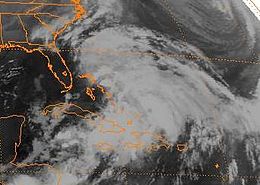Tropical Depression One (1993)
| Tropical depression (SSHWS/NWS) | |

Satellite image of the storm near the Bahamas
|
|
| Formed | May 31, 1993 |
|---|---|
| Dissipated | June 2, 1993 |
| Highest winds |
1-minute sustained: 35 mph (55 km/h) |
| Lowest pressure | 999 mbar (hPa); 29.5 inHg |
| Fatalities | 20 total |
| Areas affected | Cuba, Jamaica, Haiti, Florida, Bahamas |
| Part of the 1993 Atlantic hurricane season | |
Tropical Depression One was a weak tropical cyclone that struck Cuba and the Bahamas in May and June 1993. It formed in the western Caribbean Sea on May 31 and produced heavy rainfall along its path. In Cuba, the precipitation reached 12.4 inches (31.5 cm), which caused widespread flooding and damage in nine provinces. Over 16,500 houses were damaged, and a further 1,860 were destroyed. At least seven people were killed in the country. In neighboring Haiti, the flooding killed thirteen people, as well as thousands of livestock. Rainfall was also reported in southern Florida, which eased drought conditions. The depression eventually crossed the Bahamas and became extratropical.
The origins of the tropical depression were from a tropical wave that exited the coast of Africa on May 13. It crossed the Atlantic Ocean and Caribbean Sea, reaching a position east of the Yucatan Peninsula by May 25. The system interacted with a monsoon-type circulation over Central America, and a broad low-level circulation developed near Cozumel, Mexico. Atmospheric pressure in the region fell gradually as the system organized, and on May 31, the National Hurricane Center classified it as Tropical Depression One near the Isle of Youth. At the time of being upgraded, the circulation was located on the northwest side of the convection due to wind shear.
Throughout its duration, the depression maintained a northeast track, due to an approaching shortwave trough to its north. Late on May 31, the poorly organized center crossed western Cuba, accompanied by heavy rainfall but light winds. By the time the circulation reached the Florida Straits, it was exposed and removed from the convection, although slight intensification was anticipated. The depression accelerated northeastward through the Bahamas, passing near Nassau. Based on Hurricane Hunters observations, it maintained stronger winds in squalls away from the center, and the pressure deepened to 999 mbar (hPa; 29.5 inHg). By June 2, reconnaissance flights into the system had difficulty discerning a circulation. Later that day, the National Hurricane Center discontinued advisories, as the depression had become extratropical. It strengthened slightly to reach gale force winds as an extratropical storm, and persisted until early on June 3.
...
Wikipedia
